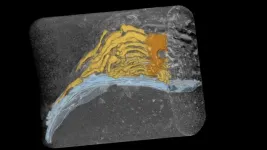(Press-News.org) Cannabis is not an effective treatment for opioid addiction, a new peer-reviewed study of thousands of people being treated for opioid use disorder suggests.
Experts, publishing their results today in The American Journal of Drug and Alcohol Abuse, have found that cannabis is having no significant effect on peoples’ use of opioids, taken outside of medical guidance.
The findings have substantial implications for U.S treatment programmes, some of which still require patients to abstain from cannabis before they qualify for potentially life-saving treatment. This is based on the belief they are more likely to use opioids non-medically if they are using cannabis.
The opposing, and increasingly popular, viewpoint, that cannabis can help wean people with opioid use disorder off opioids, is also called into question in this new study.
Opioids are effective painkillers, but they can also be addictive, and the U.S. remains in the grip of an opioid use disorder crisis.
Around 120 people die a day from drug overdoses involving opioids (prescription, such as oxycodone, and non-prescription, such as heroin) and opioid use disorder and related deaths cost the US economy more than $1 trillion a year.
As cannabis gains popularity among individuals with opioid use disorder in the U.S., its medicinal use is now legally recognized in thirty-seven states and Washington D.C. While pain remains the most common reason for medical cannabis authorization (i.e., “medical cannabis registration card”), an increasing number of states are adding “alternatives to opioids” or “opioid-treatable disorders” to their lists of approved conditions. In certain states, this includes treatment for opioid use disorder.
The study’s authors say this partly because the legalisation of the recreational use of cannabis in many states means the drug is being perceived as being less harmful than in the past. Some cannabis dispensaries have promoted medicinal cannabis as a treatment for opioid use disorder.
It isn’t clear, however, whether cannabis helps or hinders the treatment of opioid use disorder. Some studies have found it helps alleviate pain and opioid withdrawal, but others suggest it makes a return to opioids more likely.
“Clarifying how cannabis and opioids interact is crucial if we are to equip healthcare professionals to provide evidence-based addiction treatment, prevent overdose deaths and save lives,” says researcher Gabriel Costa, of University of Ribeirão Preto in Brazil.
Costa, under the mentorship of Dr. Joao P. De Aquino, of Yale University, and colleagues, carried out a systematic review and meta-analysis of existing research on the influence of cannabis on non-medical opioid use.
The meta-analysis combined the results of ten longitudinal studies involving 8,367 individuals who were receiving medication (buprenorphine, methadone or naltrexone) to treat their opioid use disorder.
As part of this, over the course of an average of 10 months, individuals were monitored for their non-medical opioid use – including the use of opioids not prescribed to them, taking more opioids than prescribed, or using opioids without a prescription.
The study compared the frequency of this use between individuals who used cannabis, typically obtained from non-regulated sources, and those who did not use cannabis.
Results showed there to be no link between cannabis use and rates of non-medical opioid use.
“Overall, we found no significant association between cannabis and non-medical opioid use among patients receiving pharmacotherapies for opioid use disorder,” states Costa.
“These findings neither confirm concerns about cannabis increasing non-medical opioid use in individuals being treated for opioid use disorder, nor do they endorse its efficacy in reducing non-medical opioid use.”
The implications for opioid use disorder treatment programmes are significant, adds Dr. De Aquino, who is a specialist in the treatment of persons with substance use disorders and co-occurring medical and psychiatric disorders.
He explains: “Our finding questions the ineffective practice of enforcing cannabis abstinence as a condition to offer life-saving medications for opioid use disorder.
“Our data suggests healthcare systems should instead adopt individualised treatment approaches which take into account each patient’s circumstances.
“This would include assessing cannabis use disorder, a problematic pattern cannabis use that affects a person’s wellbeing and ability to function, addressing pain management needs and treating co-occurring psychiatric conditions, such as depression and anxiety.”
Dr. De Aquino adds that there have been very few experimental studies into cannabis and its constituent cannabinoids’ ability to alleviate symptoms of opioid use disorder, and randomised placebo-controlled trials are needed to thoroughly assess its safety and effectiveness.
He says: “As high-potency synthetic opioids such fentanyl become increasingly available, it is of utmost importance that individuals with opioid use disorder have access to FDA-approved treatments.
“Methadone, buprenorphine, and extended-release intramuscular naltrexone – are known to be life-saving and are the cornerstone of opioid use disorder management.”
Limitations include a lack of consistency in how the studies in systematic review and meta-analysis were conducted. This includes differences in how cannabis and opioid use were measured and variations in baseline opioid use status.
In addition, although the results are applicable to general cannabis use, they may not apply to individuals with cannabis use disorder.
END
Cannabis has no clear effect on treatment of opioid addiction, US study finds
Finding has significant implications for treatment programmes – with a growing number of states authorizing cannabis use to help opioid addiction
2024-01-16
ELSE PRESS RELEASES FROM THIS DATE:
COVID-19 vaccine reduces long COVID in children
2024-01-16
Philadelphia, January 16, 2024 – Vaccination against SARS-CoV-2, the virus that causes COVID-19, reduces the risk of serious acute illness in children and adolescents. However, its role in protecting against persistent health problems in the months after COVID-19, or “long COVID,” was less clear. Now, researchers from 17 health systems in the U.S., in work led by investigators at the Children’s Hospital of Philadelphia (CHOP), have found that vaccination provides moderate protection against ...
First all-UK study of 67 million people reveals consequences of missed COVID-19 vaccines
2024-01-16
The first research study of the entire UK population highlights gaps in COVID-19 vaccine coverage. Between a third and a half of the populations of the four UK nations had not had the recommended number of COVID vaccinations and boosters by summer 2022.
Findings suggest that more than 7,000 hospitalisations and deaths might have been averted in summer 2022 if the UK had had better vaccine coverage, according to the paper, published today in The Lancet.
With COVID-19 cases on the rise and a new variant strain recently identified, this research provides a timely insight into vaccine ...
Trazadone and CBT no more effective than placebo for improving insomnia among long-term dialysis patients
2024-01-15
Below please find summaries of new articles that will be published in the next issue of Annals of Internal Medicine. The summaries are not intended to substitute for the full articles as a source of information. This information is under strict embargo and by taking it into possession, media representatives are committing to the terms of the embargo not only on their own behalf, but also on behalf of the organization they represent.
----------------------------
1. Trazadone and CBT ...
Climate change threatens global forest carbon sequestration, study finds
2024-01-15
Climate change is reshaping forests differently across the United States, according to a new analysis of U.S. Forest Service data. With rising temperatures, escalating droughts, wildfires, and disease outbreaks taking a toll on trees, researchers warn that forests across the American West are bearing the brunt of the consequences.
The study, led by UF Biology researchers J. Aaron Hogan and Jeremy W. Lichstein was published in the Proceedings of the National Academy of Sciences. The study reveals a pronounced regional imbalance in forest productivity, a key barometer of ...
Pacific kelp forests are far older that we thought
2024-01-15
The unique underwater kelp forests that line the Pacific Coast support a varied ecosystem that was thought to have evolved along with the kelp over the past 14 million years.
But a new study shows that kelp flourished off the Northwest Coast more than 32 million years ago, long before the appearance of modern groups of marine mammals, sea urchins, birds and bivalves that today call the forests home.
The much greater age of these coastal kelp forests, which today are a rich ecosystem supporting otters, sea lions, seals, and many birds, fish and crustaceans, means that they likely were a ...
Erectile dysfunction medications may increase risk of death when combined with common chest pain medication
2024-01-15
Phosphodiesterase type 5 inhibitors (PDE5i)—an erectile dysfunction drug sold under the names Viagra, Levitra, Cialis, and others—are a common medical treatment for erectile dysfunction (ED) in men with cardiovascular disease (CVD). However, a new Swedish study published today in the Journal of the American College of Cardiology suggests that patients are at higher risk for morbidity and mortality over time when PDE5is and nitrate medication are both prescribed.
Erectile dysfunction is a common condition in middle-aged and older men and is a strong predictor of coronary ...
Key moment in the evolution of life on Earth captured in fossils
2024-01-15
Curtin-led research has for the first time precisely dated some of the oldest fossils of complex multicellular life in the world, helping to track a pivotal moment in the history of Earth when the seas began teeming with new lifeforms - after four billion years of containing only single-celled microbes.
Lead author PhD student Anthony Clarke, from the Timescales of Mineral Systems Group within Curtin’s School of Earth and Planetary Sciences, said to determine the age of the fossils, researchers used volcanic ash layers like bookmarks in the geological sequence.
“Located ...
Chasing the light: Sandia study finds new clues about warming in the Arctic
2024-01-15
ALBUQUERQUE, N.M. — The Arctic, Earth’s icy crown, is experiencing a climate crisis like no other. It’s heating up at a furious pace — four times faster than the rest of our planet. Researchers at Sandia National Laboratories are pulling back the curtain on the reduction of sunlight reflectivity, or albedo, which is supercharging the Arctic’s warming.
The scientists are not armed with parkas and shovels. Instead, they have tapped into data from GPS satellite radiometers, capturing the sunlight bouncing off the Arctic. This ...
Physicists identify overlooked uncertainty in real-world experiments
2024-01-15
The equations that describe physical systems often assume that measurable features of the system — temperature or chemical potential, for example — can be known exactly. But the real world is messier than that, and uncertainty is unavoidable. Temperatures fluctuate, instruments malfunction, the environment interferes, and systems evolve over time.
The rules of statistical physics address the uncertainty about the state of a system that arises when that system interacts with its environment. But they’ve ...
Kessler Foundation receives grant to investigate impact of combining aerobic exercise and virtual reality for individuals with multiple sclerosis
2024-01-15
East Hanover, NJ – January 15, 2024 – Kessler Foundation received a $39,994 grant from the Consortium of Multiple Sclerosis Centers to investigate the impact of a unique combination of a single bout of aerobic cycling and virtual reality (VR) on processing speed in persons with multiple sclerosis (MS) and mobility disability.
Processing speed is the most common cognitive problem in persons with MS and may actually contribute to broader cognitive difficulties, according to the grant recipient, Carly Wender, PhD, research scientist in the Center for Neuropsychology ...
LAST 30 PRESS RELEASES:
For teens, any cannabis use may have impact on emotional health, academic performance
School meals could unlock major gains for human and planetary health
Menopause hormone therapy does not appear to impact dementia risk
Signature patterns of brain activity may help predict recovery from traumatic brain injury
Dresden study uncovers new key mechanism in cancer cells
New species are now being discovered faster than ever before, study suggests
Cannabis-based products show limited short-term benefit for chronic pain, with increased risk of adverse effects
Cannabis products with more THC slightly reduce pain but cause more side effects
Clearing the brain of aging cells could aid epilepsy and reduce seizures
Brain injuries linked with potential risk of suicide, new study finds
New technique lights up where drugs go in the body, cell by cell
New study finds movement of fishing fleets can reveal shifts in marine ecosystems
Embargoed: New evidence points to potential treatment for vascular dementia
Study uncovers disrupted brain balance in alcohol dependence
Working in groups can help Republicans and Democrats agree on controversial content moderation online
Structural findings reveal how distinct GPCR ligands create different levels of activation
Anything-goes “anyons” may be at the root of surprising quantum experiments
UC review: Maximizing workplace opportunity for veterans
From generation to complex control: Metasurfaces make perfect vortex beams "within reach"
Thin-film lithium niobate-based detector: recent advances and perspectives
Exploring why some people may tend to persistently make bad choices
How cells balance their protein levels
Nirsevimab vs RSVpreF vaccine for RSV–related hospitalization in newborns
Effectiveness and impact of maternal RSV immunization and nirsevimab on medically attended RSV in US children
AI gives scientists a boost, but at the cost of too many mediocre papers
Next-generation vision model maps tree growth at sub-meter precision
Genes aren’t destiny for inherited blindness, study shows
MIT study: High-fat diets make liver cells more likely to become cancerous
Exposure to multiple fine particulate matter components and incident depression in the US Medicare population
Risk of burdensome health care spending over time in the US
[Press-News.org] Cannabis has no clear effect on treatment of opioid addiction, US study findsFinding has significant implications for treatment programmes – with a growing number of states authorizing cannabis use to help opioid addiction



